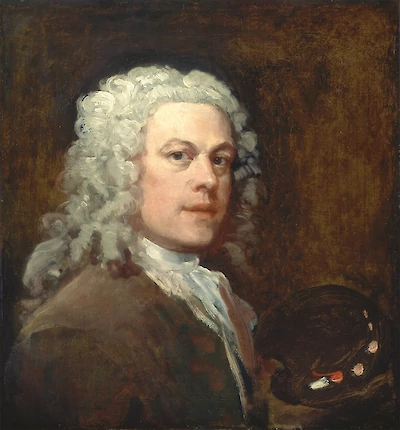Fitness of the parts to the design for which every individual thing is formed, either by art or nature, is first to be considered, as it is of the greatest consequence to the beauty of the whole. This is so evident, that even the sense of seeing, the great inlet of beauty, is itself so strongly biased by it, that if the mind, on account of this kind of value in a form, esteem it beautiful, though on all other considerations it be not so, the eye grows insensible of its want of beauty, and even begins, to be pleased, especially after it has been a considerable time acquainted with it.
 Analysis of Beauty: Plate 1 1753, William Hogarth
Analysis of Beauty: Plate 1 1753, William HogarthIt is well known, on the other hand, that forms of great elegance often disgust the eye by being improperly applied. Thus, twisted columns are undoubtedly ornamental; but as they convey an idea of weakness, they always displease, when they are improperly made use of as supports to any thing that is bulky, or appears heavy.
The bulks and proportions of objects are governed by fitness and propriety. It is this that has established the size and proportion of chairs, tables, and all sorts of utensils and furniture. It ist his that has fixed the dimensions of pillars, arches, etc. for the support of great weight, and so regulated all the orders in architecture, as well as the sizes of windows and doors, etc. Thus, though a building were ever so large, the steps of the stairs, the seats in the windows, must be continued of their usual heights, or thev would lose their beauty with their fitness: and in shipbuilding the dimensions of every part are confined and regulated by fitness for sailing. When a vessel sails well, the sailors always call her a beauty: the two ideas have such a connection!
The general dimensions of the parts of the human body are adapted thus to the uses they are designed for. The trunk is the most capacious, I on account of the quantity of its contents, and the thigh is larger than the leg, because it has both the leg and foot to move, the leg only the foot, etc. Fitness of parts also constitutes and distinguishes, in a great measure, the characteristics of objects; as, for example, the race-horse differs as much in quality, or character, from the war-horse, as to its figure, as the Hercules from the Mercury.
The race-horse, having all its parts of such dimensions as best fit the purposes of speed, acquires, on that account, a consistent character of one sort of beauty. To illustrate this, suppose the beautiful head and the gracefully-turned neck of the war-horse were placed on the shoulders of the race-horse, instead of his own awkward straight one; it would disgust, and deform, instead of adding beauty ; because the judgment would condemn it as unfit.
The Hercules, by Glicon, plate 2, has all its parts finely fitted for the purposes of the utmost strength, the texture of the human form will bear. The back, breast, and shoulders have huge bones, and muscles adequate to the supposed active strength of its upper parts; but as less strength was required for the lower parts, the judicious sculptor, contrary to all modem rule of enlarging every part in proportion, lessened the size of the muscles gradually down towards the feet; and for the same reason made the neck larger in circumference than any part of the head, figure 3, plate 3; otherwise the figure would have been burdened with an unnecessary weight, which would have been a drawback from his strength, and in consequence of that, from its characteristic beauty.
These seeming faults, which show the superior anatomical knowledge, as well as judgment, of the ancients, are not to be foimd in the leaden imitations of it near Hyde Park. These saturnine geniuses imagined they knew how to correct such apparent disproportions.
These few examples may be sufficient to give an idea of what I mean, and would have understood, by the beauty of fitness, or propriety.

